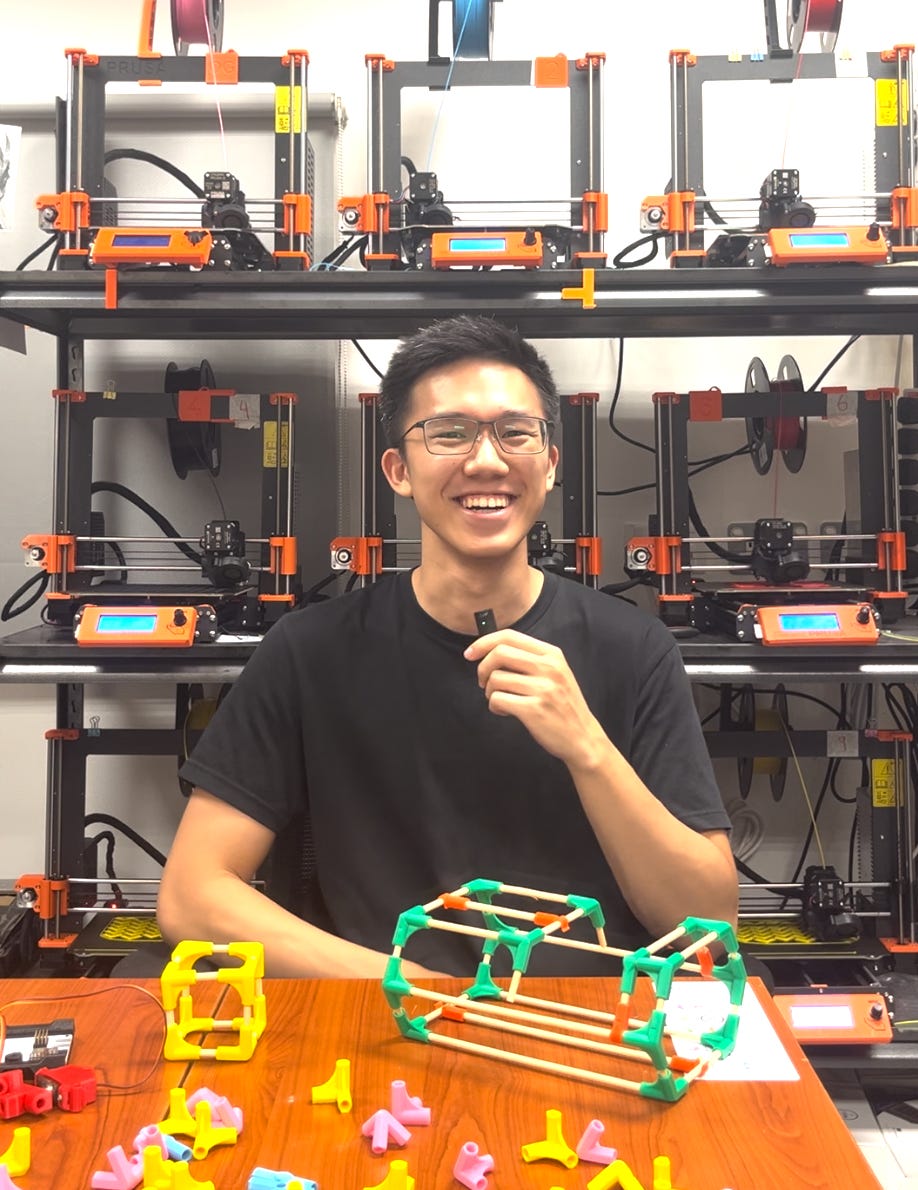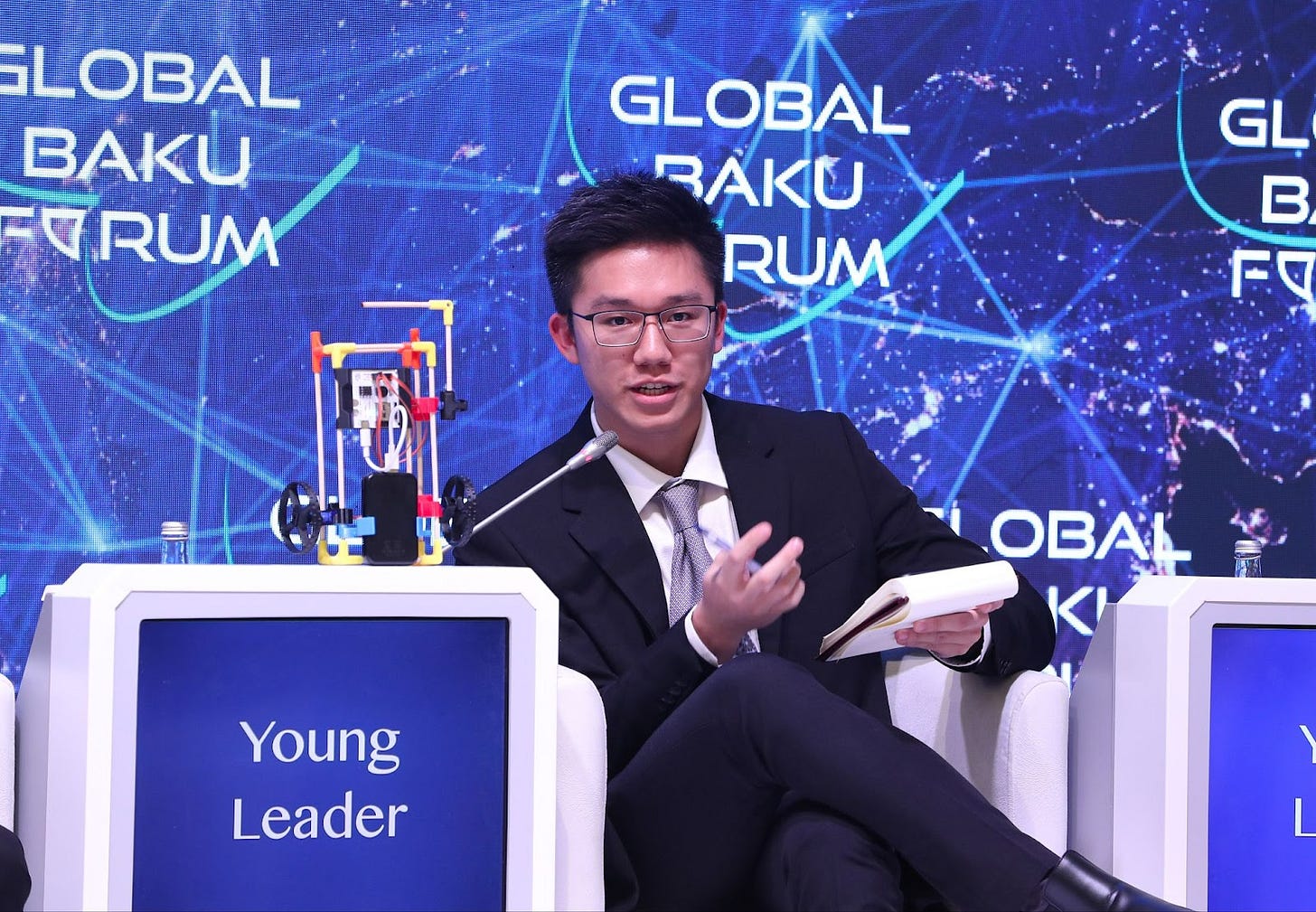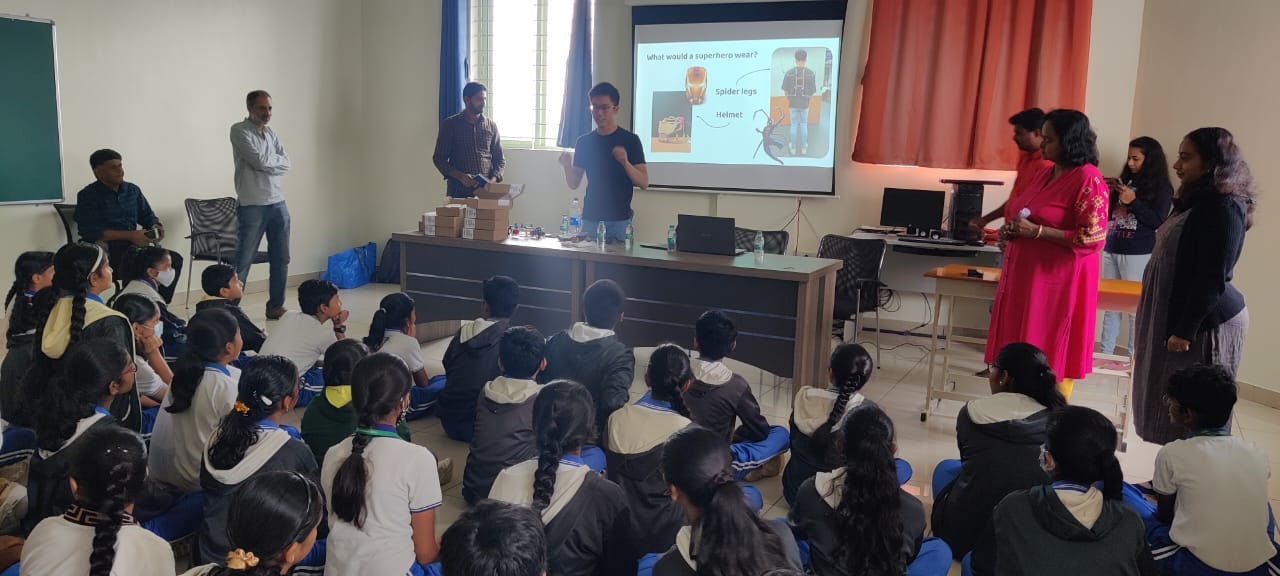#25: Reducing education inequality with chopstick robots
Ing Kai's journey from understanding his ADHD to making robotics education accessible to all
Welcome to this week’s edition of SEAmplified! Your latest insights on Southeast Asian youth in 9 minutes.
🔥 Trailblazers
Trailblazers features young startup founders, social leaders, and cultural mavericks in Southeast Asia.“I have ADHD, but that didn’t stop me from tackling education inequality”

When I first heard of how Chong Ing Kai, 21, is imparting problem-solving skills to children by getting them to build robots using chopsticks, I was intrigued.
Who would ever think that chopsticks can be used in any other settings apart from eating, let alone used to build a robot?
Ing Kai had no airs about it as he shared how it all came about.
Having realized that robotic programs are inaccessible to children from lower-income backgrounds, he decided to make a cheaper robot-building kit by looking at what’s available in his kitchen at home.
He began by experimenting with cardboard, but the material was not strong enough. He then found disposable chopsticks that were strong and sturdy, which could be built into structures and were suitable for robot-building.
“I’m not inventing anything from scratch. I’m just making use of existing materials like chopsticks, which are cheap and strong, and piece them together with systems that can do something new,” he added.
With that, he started Stick ‘Em to tackle education inequality by making STEAM (science, technology, engineering, arts, mathematics) education accessible to children.
However, tackling inequality is easier said than done, and I wondered what convinced Ing Kai to do so.
It turns out that he was shaped by his early exposure to unfairness in primary school.
Ing Kai was diagnosed with attention deficit hyperactivity disorder (ADHD) at the age of 9. While he was fidgety and impulsive during primary school, his teachers lacked an understanding of his condition and he was frequently disciplined for “misbehaving” in class.
For example, he was made to stand outside the classroom, which did not work because he couldn’t stand still, which frustrated his teachers.
After being advised by his mother to “make use of his hyperactive nature”, the teachers made Ing Kai pick up trash around the school’s canteen as a form of punishment. But Ing Kai turned it into a “trash-picking competition” with his friends instead.
He gained a notorious reputation for being a “troublemaker”, and teachers would often assume he was the culprit if something went missing in the classroom, even if he was innocent. Because of that, he would even be excluded from certain activities, and the feeling was terrible for him.
“Incidents like these made me feel that there’s a lot of injustice in the world, and I think the feeling of unfairness is something that stuck with me till today,” he shared.
Understanding himself
Ing Kai was nonchalant about his ADHD condition until the age of 12.
He eventually realized that his condition was affecting his friendships and the people around him. It was no longer just about getting into trouble in school, and he felt that there was a need to understand how ADHD was affecting him. He began with some research on Reddit, where there’s a subreddit dedicated to discussing ADHD.
From there, he realized that having ADHD was more than just about impulsivity. For instance, he learned about a problem called Rejection Sensitive Dysphoria, which affects a brain’s ability to process emotional responses when faced with rejection.
For example, if somebody said “no” to his request for something, his brain could misinterpret it as a form of hatred targeted at him.
He also learned how his medication was affecting him, such as why he lost his appetite, how it restrained his creativity, and why he lost weight and had mood swings.
“The more I researched, the more I realized that I’m not the only one faced with this situation, and I feel validated,” he said.
By understanding his ADHD condition, he was able to figure out how best to work on things without letting his condition get in the way. It has also helped him to be more sensitive to children’s needs when he runs STEAM workshops in schools.
For instance, if he found that some students were misbehaving or losing focus, he could tell if they had special needs, or if the environment was not conducive for them to learn.
Having been through the process of understanding ADHD, Ing Kai now feels that it is important for people who’re facing a similar situation to understand their condition early.
“The sad thing is that people with ADHD only realized the importance of understanding their condition in their 30s, and by then a lot of years have already been wasted because they spent their whole youth not being as productive as they could be,” he shared.
Turning passion into impact
While understanding ADHD has enabled Ing Kai to run Stick ‘Em as a founder, he also felt that he wouldn’t be creating things for social good without the support of his parents and prior exposure to societal problems.
When Ing Kai was in primary school, his father would often bring him to places like the Science Center to participate in science education activities, or Sim Lim Tower to buy broken electronic parts and fix them up at home for hours without eating or drinking.
“That’s hyperfocus, and it happens when you have ADHD and you’re very passionate about something,” he explained.
Having been inspired by influencers like Grant Thompson, who was famous for his King of Random YouTube series showcasing DIY life hacks and running experiments, Ing Kai would create dangerous objects like air cannons, tasers, and flame throwers, while thinking of ways to generate revenue out of them.
But his mother would consistently question if these objects served any purpose in helping the world, and that influenced him to help children who may not have seen a robot before to be exposed to STEAM education through Stick ‘Em.
At the same time, Ing Kai also realized that he could create things with a positive impact on society through his stints with different organizations such as Engineering Good (EG), a non-profit that’s getting engineers to build things to serve the needs of disadvantaged communities in Singapore.
For instance, people with cerebral palsy are unable to open a door while in a wheelchair, and they have to depend on their caretakers to do so. The EG team would then create a button to enable them to do so on their own.
“It’s very satisfying to be able to use your skills to help people with disabilities do simple things that we often take for granted,” he said.
Ing Kai was also teaching robotics to students in talent programs and international schools at a robotics center. While the students were learning robotics, they were not learning problem-solving skills as they were just following step-by-step instructions on how to build a robot.
“Many students asked if they can bring their robots home, and my answer is usually no because it’s very expensive,” he added.
After some research, he realized that robots are generally inaccessible to many people worldwide, and cheaper versions of a robot-building kit don’t work well. From there, he coined the idea of making STEAM education accessible to all, and started Stick ‘Em together with a few friends in 2020, at the tender age of 17!
Expanding his mission and horizon

Today, Stick ‘Em has brought STEAM education to more than 5000 children in both rural and urban areas across Southeast Asia and beyond. Ing Kai has also been to countries like Azerbaijan, Brunei, India, and Vietnam to run workshops or attend conferences.
When asked what he has seen or learned from all his travels, Ing Kai shared that while there are different customs, rules, or religions across borders, people everywhere can be quite similar as well. For instance, he was able to crack the same jokes and people would laugh.
He also felt that the joy and excitement for learning among children are the same everywhere.
“But I’ve been to countries where local kids have never seen a robot before. They can get extremely excited to see that the robot they built could move, so much more than Singaporean kids who are much more privileged,” he said.
On this note, he felt that more Singapore youths should get out to expand their horizons by experiencing different cultures and problems in the real world.
Many of his juniors have also asked how they can come up with a startup that’s as successful as Stick ‘Em, but Ing Kai feels that this is the wrong approach.
“You have to actually figure out a problem that you care deeply enough, and be ready to dedicate a few years of your life to solve it,” he said.
To him, internships, volunteering stints, or even participating in overseas exposure programs are the best ways for youths to find their passion and figure out what they can do to help the world.
For those who may have reservations about going to places that are widely perceived as “dangerous” or “less attractive”, Ing Kai has something to say, “You can stay in your little Singapore bubble, but what’s the point of that?”
Staying in the comfort zone would mean becoming stagnant and complacent, and losing the opportunity to be inspired by new adventures and perspectives.
He also acknowledges that while it could be difficult for youths from lower-income backgrounds to travel overseas, he encourages them to tap into programs organized by Singapore’s National Youth Council, which are heavily subsidized.
With that, Ing Kai is continuing to walk the talk.
He’s currently thinking of embarking on a backpacking trip around Central Asia or the Middle East after his current military service stint. Meanwhile, Stick ‘Em’s chopstick robot kit just officially made its way into Uganda, their first foray into the African region, and more product expansion plans are in the works.
But what if Stick ‘Em somehow doesn’t work out? After all, statistics suggest that about half of new businesses wouldn’t survive beyond the five-year mark. Stick’ Em will turn four this September.
“I’ll still be happy with what I’ve achieved with Stick ‘Em because I’ve learned so much from it, and I’ll always have new ideas as I think about them during my free time,” said Ing Kai with a beaming smile.
PS: Check out “3 Questions with Trailblazers”, where Ing Kai answered three random questions from us on our Instagram-exclusive video series. Follow us on Instagram @seamplified.news now!
Enjoyed today’s article? Follow SEAmplified on Instagram and LinkedIn for exclusive content, hit the subscribe button, and tell us how we did in the poll below!
Have a new idea or lead for a story, feedback on our work, or just want to say hi? Email the editor at tanzhantiam@gmail.com.




